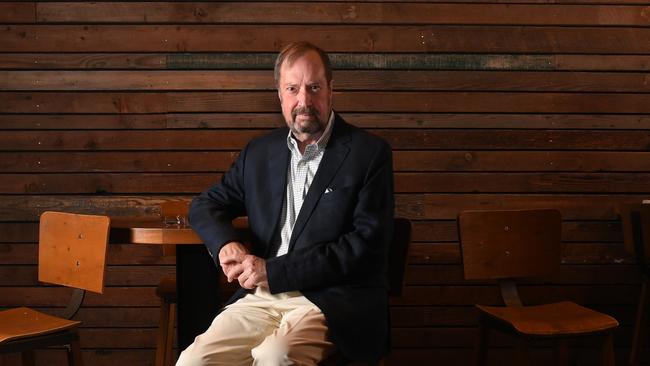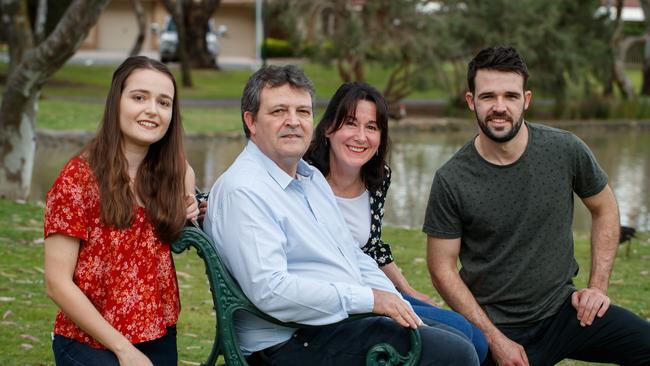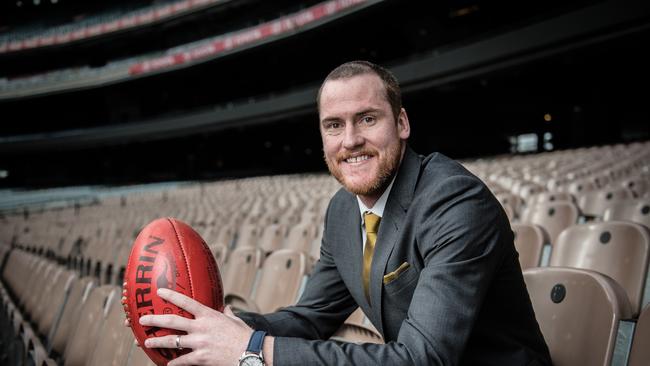SA Weekend: How science is turbocharging the immune system to find and then wipe out some of the most deadly cancers including melanoma
The evolving science of immunotherapy is helping SA patients use their own – and sometimes donor – soldier blood cells to kill a growing number of cancers, writes Penelope Debelle.
SA Weekend
Don't miss out on the headlines from SA Weekend. Followed categories will be added to My News.
DNA is the gold standard proof taken from any crime scene, the deciding factor for juries and judges, and the stuff of countless convoluted TV plots.
So imagine this: if Adelaide leukaemia patient Andrew Knox decided to moonlight as a serial killer and left a trail of blood at a scene, he would, on the evidence, get off scot-free.
Instead, the culprit would be a young German man who donated his stem cells to Knox for a transplant that brought Knox back into remission.
However, should Knox shed saliva DNA instead of blood, he would be rightly behind bars because the rest of his genetic material is still his own.
In the weird new world of immunotherapy medicine, he has a double DNA profile – his own and that of a stranger.
The conversion of his blood’s DNA from his own to someone else’s followed an extreme form of immunotherapy called blood stem cell therapy that Knox underwent at the ONJ centre in Melbourne.

The German man’s stem cells generated new T cells – the soldier blood cells whose job is to kill intruders – inside Knox, and they fought off the acute myeloid leukaemia that was about to kill him.
It turned him into what is known as a DNA chimera, a reference to the mythological Greek beast that was part lion, part goat.
In another oddity, in the aftermath of the procedure, on Day 90, his blood group switched from his old A negative to O plus.
This extraordinary intervention is at the extreme end of a revolution in immunotherapy treatment which has in the past few years saved the lives of hundreds of cancer patients in South Australia and transformed the prognosis for patients with some of the deadliest types of cancers, particularly melanoma.
It has transformed some cancer treatments by shifting focus from surgery and chemotherapy – the remove and kill strategy – to boosting the body’s own immune system so it can fight cancer on its own.
In the case of stem cell therapy, the patient’s immune system is replaced with that of a donor. In the most widely used form of immunotherapy, the patient’s own system is woken.
The problem with stem cell therapy was that it was thought to be too dangerous – often the patient would die.
“The ONJ centre refused to do them before 2013 because the complications were such that they didn’t fit in with their view of humanity; you were too likely to die, or have complications,” says Knox, who became a familiar public figure during the chemotherapy underdosing scandal. “The problem is graft versus host disease [where the donor blood cells attack the patient’s cells because they see them as foreign] but I had very little of that and I went 100 per cent over.”
A different form of immunotherapy in more widespread use harnesses the body’s own immune system to fight cancer on its own. Although there are risks, it can be a much more benign treatment compared with the traditional chemotherapy and radiotherapy where the aim is to kill – poison or burn – the cancer.
A living example of its success is Adelaide man Andrew Gambel, now 56. Facing the end of his life, he underwent immunotherapy which melted away melanomas that he fought for years but which had spread and metastasised into his brain and lungs. The last-ditch intervention not just saved him, it has led to an apparent cure.
“There are patients who have been in remission for so long that we presume that their immune system has effectively controlled or maybe even eliminated the melanoma,” says his treating specialist and South Australia’s leading medical oncologist in the field, Professor Michael Brown. “We can consider this to be a functional cure.”

Gambel, a software engineer who is married with two children, was 44 when the melanoma was first diagnosed and is now 56 so he has been dealing with the disease for a long time. The nightmare began in 2009 when he found a lump in his left calf that was diagnosed as serious invasive melanoma. It was a shock because he had no history of cancer in his family, had always been sun smart and was physically fit.
He had surgery to cut it out, including a skin graft, and hoped for the best. At that stage, given that he was diagnosed with a Stage 4 tumour that was more than four millimetres long, he had a 50 per cent change of being alive in two years.
At around the two-year mark it came back, in the same leg, and his doctors chased it down, trying to cut it all out. “Between 2012 and 2015 I had seven surgeries because it just kept coming back. It got as high as the knee,” Gambel says.
He also had radiotherapy externally to the right side of the knee and back of the calf, to at least buy some time. In November 2015, his regular scans showed things were suddenly much worse.
“I had two tumours in the brain and four in my lungs,” he says. “The prognosis at that point was very grim because where it was in the brain meant there was no way to treat it and chemo is not that effective on melanoma.”
It was a tough time, to be facing the end of life as a relatively young man with teenage children, both still at school. The family’s devastation at what was happening was particularly distressing.
“That’s the worst thing, your family gets very upset and shocked by it,” he says. “It’s very hard to go to that from being perfectly healthy with no other health issues at all.”
As a last resort, with no options for treatment, he was referred to Brown, a senior RAH medical oncologist and immunotherapy specialist who heads the hospital’s cancer clinical trials. Brown acknowledged things were grim but asked Gambel if he would consider joining a clinical trial for immunotherapy, specifically for melanoma of the brain.
Gambel says he hesitated because the potential side effects looked devastating and could ruin what quality of life he had left. He also knew that immunotherapy didn’t work for everyone but it was a last chance, and he took it. The results were miraculous.
“Basically, the scans every six weeks showed that at first it stopped growing, then after about three months the cancer started to shrink and after about eight it was completely gone,” Gambel says. “All of them disappeared from the brain and the lungs. They just melted away.”
What was for Gambel five years ago a last-resort trial is now a standard kind of immunotherapy called immune checkpoint inhibitor therapy. It is routinely used for advanced, deadly cancers including melanoma, lung cancer, kidney cancer, bladder cancer, head and neck cancer and Hodgkin lymphoma. The treatment works, fundamentally, by turning the patient’s own immune system – which had been tricked by the cancer into not recognising it as an intruder – into a weapon that fights back on its own.

It has been lifesaving for some and life-enhancing for others. It explains why David Gulpilil, the charismatic Indigenous actor who two years ago was so desperately ill with lung cancer that he was clinging to life by a thread, is still with us, living quietly in Murray Bridge.
“David is still a work in progress, but there is no doubt that immunotherapy has extended his life, and it has improved the quality of his life,” says long-time friend and colleague, film director Rolf de Heer.
Former federal minister, Arthur Sinodinos, was desperately ill with lymphoma in 2017 and underwent a stem cell transplant similar to Knox, again from a young German donor. He is now in Washington as Australia’s Ambassador to the US.
Another of the relapsed, underdosed chemotherapy patients is in full remission from acute myeloid leukaemia after a transplant that used cells from a Dutch donor, while AFL Hawthorn hero, Jarryd Roughead, is cancer free after a melanoma on his lip had metastasised into his lungs. Roughead, who returned to football, was treated with the same combination of immunotherapy drugs as Gambel.
Knox’s road was far from easy but the fact he is here is a miracle. Having relapsed in December 2016 with acute myeloid leukaemia, a deadly blood cancer that he fought into remission with chemotherapy two years earlier, his outlook was bleak.
“There was a window of four to six months’ lifespan left in which a stem cell transplant had to occur,” he says.
A donor who was a near enough match was found in Germany and Knox was forced into remission through a bombardment of chemotherapy that fell just short of killing him. Stem cells were then harvested from the blood of the donor in Germany and a medical courier flew there, at the federal government’s expense, and brought back stem cells harvested from the donor just before. The courier flew to Melbourne where the cells were checked at the Peter MacCallum Centre then sent to the ONJ centre where Knox began receiving them in a drip transfusion a couple of hours later.
What no one knew was that the donor had at some point contracted Epstein-Barr virus, possibly as glandular fever, and this can be a forerunner to lymphoma. On day 67 Knox woke up riddled with lumps; lymphomas were taking hold throughout his body. He was bombarded with treatment but the complication left him with residual damage, including a spinal lesion causing a loss of sensation from the waist down, which makes walking difficult.
But it was his last hope, and he is grateful it worked.
“Absolutely,” says Knox who still works part-time. “If I hadn’t got that transplant, I would have been dead by August 2017, no question.”
Stem cell therapy had been available, in theory, for some time, but Knox’s physician, David Yeung, says that in the past, the process of wiping out a patient’s own immune system prior to the transplant meant the patient was at high risk of organ failure.

It was, at best, offered to younger patients and not to someone like Knox in their late 60s.
It succeeds when the donor’s immune system takes hold and reconstitutes itself within the patient, replacing the faulty system that let the cancer in; when the revved-up immune system comes across a stray leukaemia cell it destroys it.
“The good thing about a stem cell transplant is it will lead to cure long-term; the bad thing is that initially you risk organ damage, infection, graft versus host disease and, even then, there are some leukaemia cells that might escape,” Yeung says.
The unusual side effect of becoming a chimera with different DNA coexisting in the one body is odd but not sinister. “There is a risk of graft versus host disease because the gut and the skin are still driven by Andrew’s DNA,” Yeung says. “But Andrew won’t be growing blonde hair.”
Immune checkpoint inhibitor therapy is the more widespread form of immunotherapy but a less common form, known as CAR-T cell therapy, is also transforming some cancer treatments. CAR-T cell therapy uses part of the patient’s immune system – the T cells which are the hunters and killers in a person’s immune system – and extracts and trains them through an act of genetic engineering to kill leukaemia cells. When they go back in the body, patient and doctor ideally stand back and watch the battle unfold.
CAR-T cell therapy is currently Medicare funded only for use with B-cell cancers like acute lymphoblastic leukaemia, and then only for patients aged 26 and under. “It is not happening commercially in SA but we do have access to it through our Melbourne colleagues,” says Yeung.
But Yeung says there are attempts underway to use the same technology to treat other cancers, such as training the T cells against a molecule that is a marker for myeloma. “Colleagues are doing that research so patients can have access to that through clinical trials,” he says.
The immune checkpoint inhibitor therapy that has transformed the lives of people like Andrew Gambel and David Gulpilil uses drugs to overcome the trick by which the cancer cells hid themselves from the patient’s own immune system. This was the deceit that allowed the cancer to take hold in the first place.
“Some cancers use a molecule to tell the T cells to ‘stand down’ but the drug can block that (message) by using an inhibitor, so the T cell will switch back on and attack the cancer,” Yeung says.
This technique is in particular driving the revolution in the treatment of patients with melanoma and, to a lesser extent, lung cancer. In a short space of time it transformed melanoma treatment from a last-resort clinical trial into a frontline treatment that not just melts the existing cancer, but improves the likelihood of it not coming back.
“This has happened particularly with melanoma where it is now used as an adjunct to surgery. But I think we will see these drugs used in other forms of cancers, in the earlier stages and after surgery,” Brown says. “What we try to do is get to the disease earlier to stop it from getting worse.”

While melanoma is the standout success, there is a lucky group of about 20 per cent of patients with other cancers, including bladder, kidney, and head and neck, who are also getting long-term benefit from immunotherapy even if the cancer has spread.
“Without doubt the biggest breakthrough is with melanoma. There are patients who have been in remission for so long that we presume that their immune system has effectively controlled or maybe even eliminated the melanoma. We can consider this to be a functional cure,” Brown says.
Like all cancer treatments, the outcome each time is unsure and the emotional difficulty for patients and doctors is in not knowing exactly who can be helped and who cannot. The immunotherapy could be targeted at the correct molecule but until it is tried, nobody can be sure it will work.
“There are a number of things we don’t know, and we don’t predict well who is going to respond and who isn’t,” says Yeung who specialises in the treatment of blood cancers. “At this early stage, it is still a bit of an assumption; let’s have a go and see if it will work.”
To help things along, a combination of therapies might be tried but even then, is it better to try immunotherapy first, or chemotherapy? “I think we don’t know enough,” says Yeung.
Whether immunotherapy can eventually be used as a treatment for common cancers like breast or colorectal is a complicated question which at present has no answer. But for the lucky few like Gambel, it has transformed melanoma from a surgical disease, which in his case had been tried and failed, into a medical one, which might be treated first without surgery or the ravages of chemotherapy.
“The worst I got was an itchy rash because it does attack your skin but since I’ve come off the treatment, that has settled down a lot,” says Gambel who is working full-time and leading a normal life.
“The family was rapt, they were so pleased it helped. I can’t speak highly enough of Michael and the people down there. It’s really good.”
